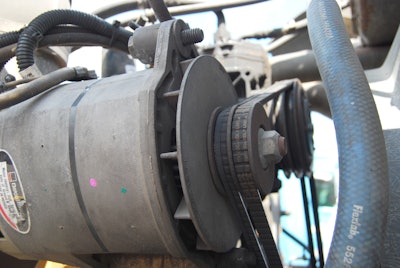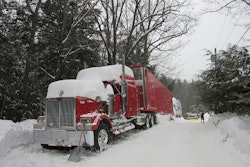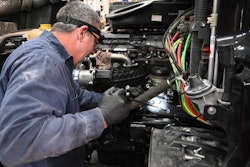Newer compounds used to make rubber hoses have improved their lifecycle dramatically, but they haven’t changed the physics involved. Friction, pressure and heat still can cause component wear, even to the ethylene propylene diene monomer (EPDM) hoses in use today.
Hose failures lead to more than half of all radiator coolant hose replacements, according to the IMR Automotive Research Group. Drew Conkling, global product line management director for hose maker Gates, recommends hose replacement at 90,000 miles to avoid an unnecessary breakdown. Severe-duty cycles such as towing, frequent stop-and-go, high-idle and hot weather can reduce that replacement range, Conkling said.
 Belts and hoses usually fail internally without noticeable signs. When a visual failure indicator appears, it’s usually near the end of the component’s lifespan, and it might be too late to avoid a serious breakdown.
Belts and hoses usually fail internally without noticeable signs. When a visual failure indicator appears, it’s usually near the end of the component’s lifespan, and it might be too late to avoid a serious breakdown.Extended-life coolants pose another challenge, as hoses become a maintenance afterthought. Conkling said many engine manufacturers have removed coolant filters from the system, and general maintenance practices nearly have eliminated the filter cartridges once used by fleets.
“Couple that with the lack of the latest information on how to handle coolants correctly, and it creates failure modes for both radiators and water pumps that border on unacceptable,” he said.
The average annual replacement rate for the upper and lower radiator hose is only 1.33%, said Tom Lee, automotive aftermarket products marketing manager for Continental Contitech, citing 2018 industry data.

For coolant and fuel, internal hose degradation can be caused by a variety of things, but it most commonly is due to fluid contamination, Conkling said. A sampling of warranty claims shows 40% of radiator failures and 95% of water pump failures are tied directly to the coolant’s condition at the time of repair.
“With the coolant hose, eventually the contamination particles can clog the radiator [or] cause the hose or water pump to fail,” he said. “But you generally would not notice [performance issues] until then.” That makes it more vital to conduct close visual hose inspections by looking for cracking, swelling, splits and cuts.
“Rubber parts – belts and hose – will typically fail internally without any noticeable signs,” Lee said. “For hose, check for extreme softness or hardness. The visual signs of failure will come close to the end of product life and may be too late. A belt or hose that fails on the road can be catastrophic and most likely will always require a tow.”
Lee said hoses should be inspected at all service intervals. “The ideal time is at the time of an oil change,” he said.
The upper radiator hose moves coolant to the radiator at peak temperature and is subject to the highest amount of heat — and the highest risk of failure. However, the entire cooling system is designed for a similar lifespan, and the lower hose and heater hoses are likely to fail soon after the upper hose, Conkling said.
“You may as well replace the upper and lower hoses at the same time to save money on labor and minimize the chances of the vehicle breaking down,” he said. If the truck is a high-mileage vehicle, inspect and/or replace the thermostat and radiator cap, and also flush the coolant system since all the plumbing will be removed, Conkling said.
The most obvious sign of hose trouble, other than a rupture, may be a leak. He advised against coolant system leak-stop additives “because they can obstruct the radiator and heater core, causing potential damage to other components such as water pump seals,” adding that the additives are ineffective on hose leaks.
Conkling said air brake hoses with chafing “beyond the outer layer should be replaced” and recommended adding a hose guard or choosing a hose with an abrasion-resistant cover. Since air brake hoses only pass air along the system, there is minimal degradation to the internal hose, he said.
When nylon hoses are manufactured, there is moisture in the tube, and the moisture evaporates over time, causing the tube to dry out, crack and fail, Conkling said. “Other failure modes are rocks and road debris,” he said.











